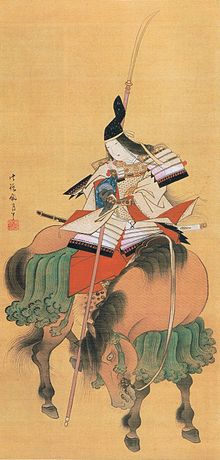Tomoe Gozen
Tomoe Gozen | |
|---|---|
| 巴 御前 | |
 Tomoe Gozen, painting by Shitomi Kangetsu | |
| Occupation | Onna-musha |
| Years active | Late 12th century (Heian period) |
Tomoe Gozen (巴 御前, Japanese pronunciation: [tomo.e][1]) was an onna-musha from the late Heian period of Japanese history. She served samurai lord Minamoto no Yoshinaka during the Genpei War and was a part of the conflict that led to the first shogunate. [2][3]
Her story in the Tale of the Heike influenced several generations of samurai. Tomoe is often celebrated in books, music, poems, films, historical novels, and culture in general.[2][3]
Genpei War[edit]

She commanded, under the leadership of Yoshinaka, 300 samurai against 2,000 warriors of the rival Taira clan during the war. After defeating the Taira in 1182 and driving them into the western provinces, Yoshinaka took Kyoto and desired to be the leader of the Minamoto clan. His cousin Yoritomo was prompted to crush Yoshinaka, and sent his brothers Yoshitsune and Noriyori to kill him.
Yoshinaka fought Yoritomo's forces at the Battle of Awazu on February 21, 1184, where Tomoe Gozen took at least one head of the enemy. Although Yoshinaka's troops fought bravely, they were outnumbered and overwhelmed. When Yoshinaka was defeated there, with only a few of his soldiers standing, he told Tomoe Gozen to flee because he wanted to die with his foster brother Imai no Shiro Kanehira and he said that he would be ashamed if he died with a woman.[4]
There are varied accounts of what followed. At the Battle of Awazu in 1184,[5] she is known for beheading Honda no Morishige of Musashi.[6] She is also known for having killed Uchida Ieyoshi and for escaping capture by Hatakeyama Shigetada.[7] After Tomoe Gozen beheaded the leader of the Musashi clan, she presented his head to her master Yoshinaka.[8]
Notes[edit]
- ^ Note: Gozen is not a name, but rather an honorific title, usually translated to "Lady", though the title was rarely bestowed upon men as well.
- ^ a b Pennington, Reina (2003). Amazons to Fighter Pilots - A Biographical Dictionary of Military Woman (Volume Two). Westport, Connecticut: Greenwood Press. pp. 437–438. ISBN 978-0-313-32708-7.
- ^ a b Turnbull, Stephen (2012-01-20). Samurai Women 1184–1877. Bloomsbury Publishing. pp. 36–37. ISBN 978-1-84603-952-2.
- ^ The Tales of the Heike. Translated by Burton Watson. Columbia University Press. 2006. p. 86. ISBN 9780231138031.
- ^ Turnbull, Stephen (1998). The Samurai Sourcebook. Cassell & Co. p. 204. ISBN 978-1854095237.
- ^ Faure, Bernard. (2003). The Power of Denial: Buddhism, Purity, and Gender, p. 211, p. 211, at Google Books; Kitagawa, p. 521.
- ^ Joly, Henri L. (1967). Legend in Japanese Art, p. 540.
- ^ Salmonson, Jessica Amanda (2015-04-07). Thousand Shrine Warrior. Open Road Media. ISBN 9781453293836.
References[edit]
- Faure, Bernard (2003). The Power of Denial: Buddhism, Purity, and Gender. Princeton: Princeton University Press. ISBN 978-0-691-09170-9; ISBN 978-0-691-09171-6; OCLC 49626418.
- Joly, Henri L. (1967). Legend in Japanese Art: A Description of Historical Episodes, Legendary Characters, Folk-lore Myths, Religious Symbolism, Illustrated in the Arts of Old Japan. Rutland, Vermont: Tuttle. ISBN 978-0-8048-0358-8; OCLC 219871829.
- Kitagawa, Hiroshi and Bruce T. Tsuchida, ed. (1975). The Tale of the Heike. Tokyo: University of Tokyo Press. ISBN 0-86008-128-1; OCLC 164803926.
- McCullough, Helen Craig (1988). The Tale of the Heike. Palo Alto, California: Stanford University Press. ISBN 978-0-8047-1418-1; OCLC 16472263.
- Nussbaum, Louis Frédéric and Käthe Roth (2005). Japan Encyclopedia. Cambridge: Harvard University Press. ISBN 978-0-674-01753-5; OCLC 48943301.
External links[edit]
- Famous Women of Japanese History Archived 2012-03-29 at the Wayback Machine. The Samurai Archives Japanese History Page.
- Shea, L. "Tomoe Gozen - Female Samurai". Bella Online, 2009.
- 1150s births
- 1247 deaths
- 12th-century Japanese women
- 13th-century Japanese women
- 12th-century Japanese people
- 13th-century Japanese people
- Japanese folklore
- Japanese women in warfare
- Women warriors
- Samurai
- Minamoto clan
- Women of medieval Japan
- Women in 12th-century warfare
- People of the Genpei War
- People of Heian-period Japan
